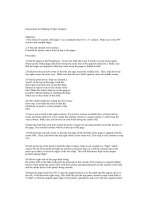36435 how to describe a painting
Bạn đang xem bản rút gọn của tài liệu. Xem và tải ngay bản đầy đủ của tài liệu tại đây (227.05 KB, 2 trang )
A description of a painting may have the following structure:
1st Paragraph: Details of the Painting (Title, Artist, Materials, Size, Location)
The title is generally written in italics. You could start by defining the painting in terms of art form or type.
The painting can be a portrait, a self-portrait, a land/sea/cityscape, a still-life or an abstract painting .
Say also what period it is from (‘It dates from…’ or ‘It was painted in…’). Here is a list of the main periods
in the history of art: Middle Ages, Renaissance, Baroque, Neoclassicism, Romanticism, Modern Art,
Impressionism, Symbolism, Art Nouveau, Cubism, Futurism, Surrealism.
The most common painting techniques are oil on canvas, watercolour, pastel on paper, tempera on board or
wood panel.
You can say: ‘The painting measures … by… (inches/cm) and it is painted in…’.
Finally, talk about the museum/gallery where it is housed. You can write: ‘It is housed in … or ‘It hangs in
…’.
2nd Paragraph: Description (Subject Matter and Structure)
The subject may be religious or it may be a natural scenery (mountains, hills, valleys, fields, woods, sky). If
it is a portrait, it can be a family portrait, a self-portrait, a nude.
A still-life may have as a subject a vase with flowers, some books or some fruit.
Finally a historical subject may represent a hero of the past or mythological figures.
The verbs that you may need to describe the subject are: to depict, to show, to represent, to illustrate, and to
portray.
At this point you can describe what you see in the foreground, in the middle ground, and in the background.
3rd Paragraph: Technique and Colours
Talking of technique, you might consider perspective and sfumato.
Lines may be straight or curving, and shapes are geometric, spherical or linear
Brushstrokes may be broad, loose, fine or blended, while texture can be rough/smooth, glossy/opaque.
As for colours, remember that warm colours are yellow, orange, and red; cold colours are blue, purple, and
green.
Colours may also be pale or bright, brilliant or soft, light or dark.
4th Paragraph: Interpretation (Theme, Symbols, Atmosphere)
The theme of a painting may be the natural/urban world, life and death, myth, or a historical event. The verbs
you may need to describe symbols are to symbolise, to be a symbol of, to stand for or to represent.
Finally, describe the atmosphere. The following adjectives may be useful: peaceful, gloomy, sad, serene,
violent.









